Geochemical Analysis of Two Samples of Bitumen from Jars Discovered on Muhut and Masirah Islands (Oman)
Abstract
:1. Introduction
2. Materials and Methods
2.1. Archaeological Samples
2.2. Analytical Procedures
3. Results and Discussion
3.1. Gross Composition of Dichloromethane Extract
3.2. Isotope Data
3.3. Molecular Chemistry
4. Conclusions
Author Contributions
Funding
Institutional Review Board Statement
Informed Consent Statement
Acknowledgments
Conflicts of Interest
References
- Connan, J.; Priestman, S.; Vosmer, T.; Komoot, A.; Tofighian, H.; Ghorbani, B.; Engel, M.H.; Zumberge, A.; van de Velde, T. Geochemical analysis of bitumen from West Asian torpedo jars from the c.8th century Phanom-Surin shipwreck in Thailand. J. Archaeol. Sci. 2020, 117, 105111. [Google Scholar] [CrossRef]
- Connan, J.; Carter, R.; Crawford, H.; Tobey, M.; Charrié-Duhaut, A.; Jarvie, D.; Albrecht, P.; Norman, K. A comparative geochemical study of bituminous boat remains from H3, As-Sabiyah (Kuwait), and RJ-2, Ra’s al-Jinz (Oman). Arab. Arch. Epig. 2005, 16, 21–66. [Google Scholar] [CrossRef]
- Connan, J.; Carter, R.A. geochemical study of bituminous mixtures from Failaka and Umm-an-Namel (Kuwait), from the Early Dilmun to the Early Islamic period. Arab. Arch. Epig. 2007, 18, 139–181. [Google Scholar] [CrossRef]
- Connan, J. Technical Report on the Comparative, Compositional and Isotopic Analysis of the H3 Bitumen. In Maritime Interactions in the Arabian Neolithic: Evidence from H3, As-Sabiyah, an Ubaid-Related Site in Kuwait; Carter, R., Crawford, H., Eds.; American School of Prehistoric Research Monograph Series: Boston, MS, USA; Brill: Leiden, The Netherlands, 2010; Appendix II; pp. 261–287. [Google Scholar]
- Kennet, D. Sasanian and Islamic Pottery from Ras al-Khaimah: Classification Chronology and Analysis of Trade in the Western Indian Ocean; British Archaeological Reports (International Series), 1248, Society for Arabain Studies Monographs 1; Archeopress: Oxford, UK, 2004. [Google Scholar]
- Carter, R. Ceramics of the Qatar National Museum. A Report and Catalogue. Unpublished Report, Oxford Brooks Archaeology and Heritage; 2011. Available online: https://www.academia.edu/700174/Ceramics_of_the_Qatar_National_Museum. (accessed on 19 August 2021).
- Empereur, J.-Y. Observations sur l’Amphore “Letaconnoux”. In Hommages à Jean Leclant; Institute français de archéologie orientale: Cairo, Egypt, 1993. [Google Scholar]
- Combès, J.-L.; Louis, A. Les Potiers de Djerba, Centre des Arts et Traditions Populaires, Tunis; Secrétariat d’État aux Affaires Culturelles et à l’Information: Tunis, Tunisia, 1967. [Google Scholar]
- Peacock, D.; Williams, D.; James, S. Bitumen as ships’ ballast and the Roman incense trade. In Food for the Gods, New Light on the Ancient Incense Trade; Peacock, D., Williams, D., Eds.; Oxbow Books: Oxford, UK, 2007; pp. 28–70. [Google Scholar]
- Al-Shanfari, A.A.B. The Archaeology of Masirah Island, Sultanate of Oman. Ph.D. Thesis, University of Naples Federico II, Naples, Italy, 1987. [Google Scholar]
- Weisgerber, G.; Al-Shanfari, A.A.B. Archaeology in the Arabian Sea. Masirah and Al Hallaniyyat Islands; Ministry of Heritage and Culture Sultanate of Oman: Muscat, Oman, 2013. [Google Scholar]
- Priestman, S.M.N. Ceramic Exchange and the Indian Ocean. Economy (AD 400-1275). II: Indian Ocean. Pottery Classification; British Museum Research Publication: London, UK, 2021. [Google Scholar] [CrossRef]
- Tomber, R.; Spataro, M.; Priestman, S. Early Islamic torpedo jars from Siraf: Scientific analyses of the clay fabric and source of Indian Ocean transport containers. J. Br. Inst. Persian Stud. 2020. [Google Scholar] [CrossRef]
- Lischi, S.; Odelli, E.; Perumal, J.L.; Lucejko, J.L.; Ribechini, E.; Mariotti Lippi, M.; Selvaraj, T.; Perla Colombini, M.; Raneri, S. Indian Ocean trade connections: Characterization and commercial routes of torpedo jars. Herit. Sci. 2020, 8, 1–14. [Google Scholar] [CrossRef]
- Durand, C. From ‘ovoid jars’ to ‘torpedo jars’: Investigations into bitumen-lined transport containers in the Gulf and the Indian Ocean in antiquity (second century BCE–third century CE). Arab. Arch. Epig. 2021, 1–12. [Google Scholar] [CrossRef]
- Guy, J. The Phanom Surin shipwreck, a Pahlavi inscription, and their significance for the history of early lower Central Thailand. J. Siam Soc. 2017, 105, 179–196. [Google Scholar]
- Chern, Y.S. Various ceramics. In The Belitung Wreck. Sunken Treasures from Tang China; Ward, J., Kotitsa, K., Eds.; Seabed Explorations: Nelson, New Zealand, 2004; pp. 640–655. [Google Scholar]
- Simpson, S.J. The land behind Rishahr: Sasanian funerary practices on the Bushehr Peninsula. In Afarin Nameh. Essays on the Archaeology of Iran in Honour of Mehdi Rahbar; Moradi, Y., Ed.; The Research Institute of Cultural Heritage Tourism: Tehran, Iran, 2019; pp. 111–124. [Google Scholar]
- Kawamata, M. Telūl Hamediyāt near Gubba and Songor: Part II. Al-Rāfidān 1990, 11, 175–188. [Google Scholar]
- Al-Haditti, A.-M.M.A.R. Umm Keshm –Summary report. Mesopotamia 1995, 30, 217–239. [Google Scholar]
- Stern, B.; Connan, J.; Blakelock, E.; Jackman, R.; Coningham, R.A.E.; Heron, C. From Susa to Anaradhapura: Reconstructing aspects of trade and exchange in bitumen-coated ceramic vessels between Iran and Sri Lanka from the third to the ninth centuries AD. Archaeometry 2008, 50, 409–428. [Google Scholar] [CrossRef]
- Blair, A.; Kennet, D.; al-Duwīsh, S. Investigating an early Islamic landscape on Kuwait Bay: The archaeology of historical Kadhima. Proc. Semin. Arab. Stud. 2012, 42, 13–26. [Google Scholar]
- Carter, R.A. Christianity in the Gulf during the first centuries of Islam. Arab. Arch. Epig. 2008, 19, 71–108. [Google Scholar] [CrossRef]
- Sasaki, T.; Sasaki, H. 1995 excavations at Jazirat al-Hulayla, Ras al-Khaimah. Bull. Archaeol. Univ. Kanazawa 1996, 23, 37–178. [Google Scholar]
- Tofighian, H. Ancient torpedo jars of Iran (Persian Gulf). In Archaeology and Conservation Along the Silk Road; Krist, G., Zhang, L., Eds.; Conference 2016 Postprints; Böhlau Verlag: Köln, Germany, 2018; pp. 63–82. [Google Scholar]
- Charpentier, V.; Berger, J.-F.; Crassard, R.; Borgi, F.; Davtian, G.; Méry, S.; Phillips, C.S. Conquering new territories: When the first black boats sailed to Masirah Island. Proc. Semin. Arab. Stud. 2013, 43, 85–98. [Google Scholar]
- Blue, L.; al-Jahwari, N.S.; Staples, E.; Giorgio, L.; Croce, P.; Ghidoni, A.; Al Busaidi, A.N.; Belfioretti, L. Maritime footprints: Examining the maritime culture landscape of Masirah Island, Oman, past and present. Proc. Semin. Arab. Stud. 2014, 44, 53–68. [Google Scholar]
- West, N.; Alexander, R.; Kagi, R.I. The use of silicalite for rapid isolation of branched and cyclic fractions in petroleum. Org. Geochem. 1990, 15, 499–501. [Google Scholar] [CrossRef]
- Coplen, T.B. Normalization of oxygen and hydrogen isotope data. Chem. Geol. 1988, 72, 293–297. [Google Scholar] [CrossRef]
- Coplen, T.B.; Qi, H. Applying the silver-tube introduction method for thermal conversion elemental analyses and a new delta 2H value for NBS 22 oil. Rapid Commun. Mass Spectrom. 2010, 24, 2269–2276. [Google Scholar] [CrossRef]
- Coplen, T.B. Guidelines and recommended terms for expression of stable-isotope-ratio and gas ratio measurement results. Rapid Commun. Mass Spectrom. 2011, 25, 2538–2560. [Google Scholar] [CrossRef]
- Brand, W.A.; Coplen, T.B.; Vogl, J.; Rosner, M.; Prohaska, T. Assessment of inter-national reference materials for isotope-ratio analysis (IUPAC technical report). Pure Appl. Chem. 2014, 86, 425–467. [Google Scholar] [CrossRef]
- Forbes, R.J. Studies in Ancient Technology. Bitumen and Petroleum in Antiquity, 2nd ed.; E.J. Brill: Leiden, The Netherlands, 1964; pp. 1–123. [Google Scholar]
- Marschner, R.F.; Wright, H.T. Asphalt from Middle Eastern Archaeological Sites. In Archaeological Chemistry 1, Advances in Chemistry Series; Paléorient:: Chicago, IL, USA,, 1978; pp. 97–112. [Google Scholar]
- Connan, J.; Kozbe, G.; Kavak, O.; Zumberge, J.; Imbus, K. The bituminous mixtures at Kavuşan Höyük (SE Turkey) from the end of the 3rd millennium (2000 BC) to the Medieval period (AD 14th century): Composition and origin. Org. Geochem. 2013, 54, 2–18. [Google Scholar] [CrossRef]
- Connan, J.; Oates, J. The bitumen of Tell Brak from the Middle Uruk (c.3500 BC) to Late Bronze Age (c.1280 BC). J. Hist. Archaeol. Anthropol. Sci. 2018, 3, 756–769. [Google Scholar]
- Brown, K.; Connan, J.; Poister, K.M.; Vellanoweth, R.L.; Zumberge, J.; Engel, M.H. Sourcing archaeological asphaltum (bitumen) from the California Channel Islands to submarine seeps. J. Archaeol. Sci. 2014, 43, 66–76. [Google Scholar] [CrossRef]
- Daneels, A.; Romo de Vivar-Romo, A.; Linares-Jurado, A.; Reyes-Lezama, M.; Tapia-Mendoza, E.; Morales-Puente, P.; Cienfuegos-Alvarado, E.; Otero-Trujano, F.J. Chemical analysis of bitumen paint on classic period Central Veracruz ceramics, Mexico. J. Archaeol. Sci. Rep. 2018, 17, 657–666. [Google Scholar] [CrossRef]
- Faraco, M.; Pennetta, A.; Fico, D.; Eramo, G.; Beqiraj, E.; Muntoni, I.M.; Egidio De Benedetto, G. Bitumen in potsherds from Two Apulian Bronze Age settlements, Monopoli and Torre Santa Sabina: Composition and origin. Org. Geochem. 2016, 93, 22–31. [Google Scholar] [CrossRef]
- Rullkötter, J.; Wendish, D. Microbial alteration of 17α(H)-hopane in Madagascar asphalts: Removal of C-10 methyl group and ring opening. Geochim. Cosmochim. Acta 1982, 46, 1543–1553. [Google Scholar] [CrossRef]
- Seifert, W.K.; Moldowan, J.L.; Demaison, G.J. Source correlation of biodegraded oils. Org. Geochem. 1984, 6, 633–643. [Google Scholar] [CrossRef]
- Chosson, P.; Connan, J.; Dessort, D.; Lanau, C. In vitro biodegradation of steranes and terpanes: A clue to understanding geological situations. In Biological Markers in Sediments and Petroleum; Albrecht, P., Moldowan, J.M., Philp, P., Eds.; Prentice Hall: Hoboken, NJ, USA, 1991; pp. 320–349. [Google Scholar]
- Chosson, P.; Lanau, C.; Connan, J.; Dessort, D. Biodegradation of refractory hydrocarbon biomarkers from petroleum under laboratory conditions. Nature 1991, 351, 640–642. [Google Scholar] [CrossRef]
- Connan, J.; Genç, E.; Kavak, O.; Engel, M.H.; Zumberge, A. Geochemical study of bituminous samples of Kuriki Höyük (SE Turkey) from 4000 BCE to 200 CE: Composition and origin. J. Archaeol. Sci. Rep. 2021. resubmitted (under review). [Google Scholar]
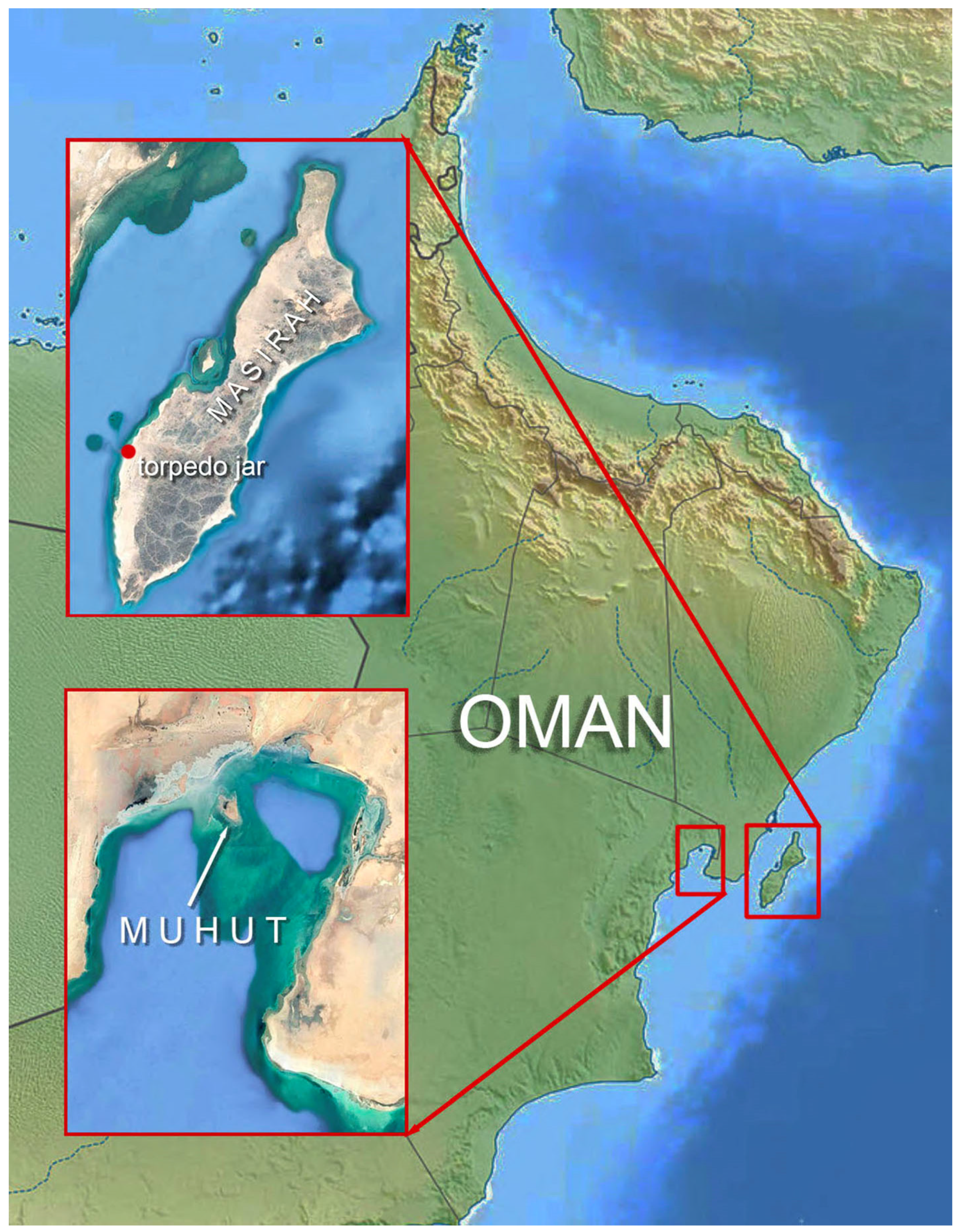
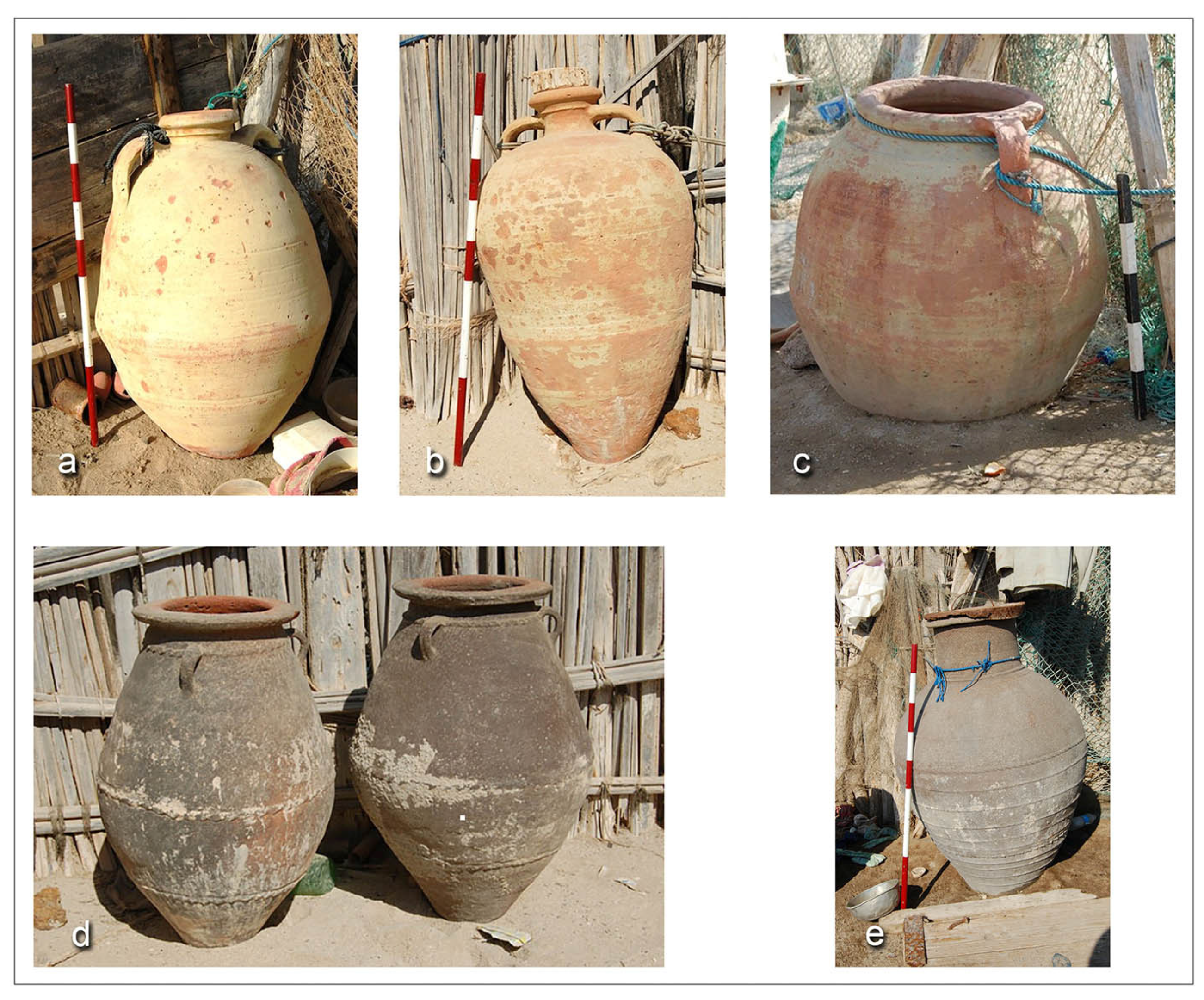
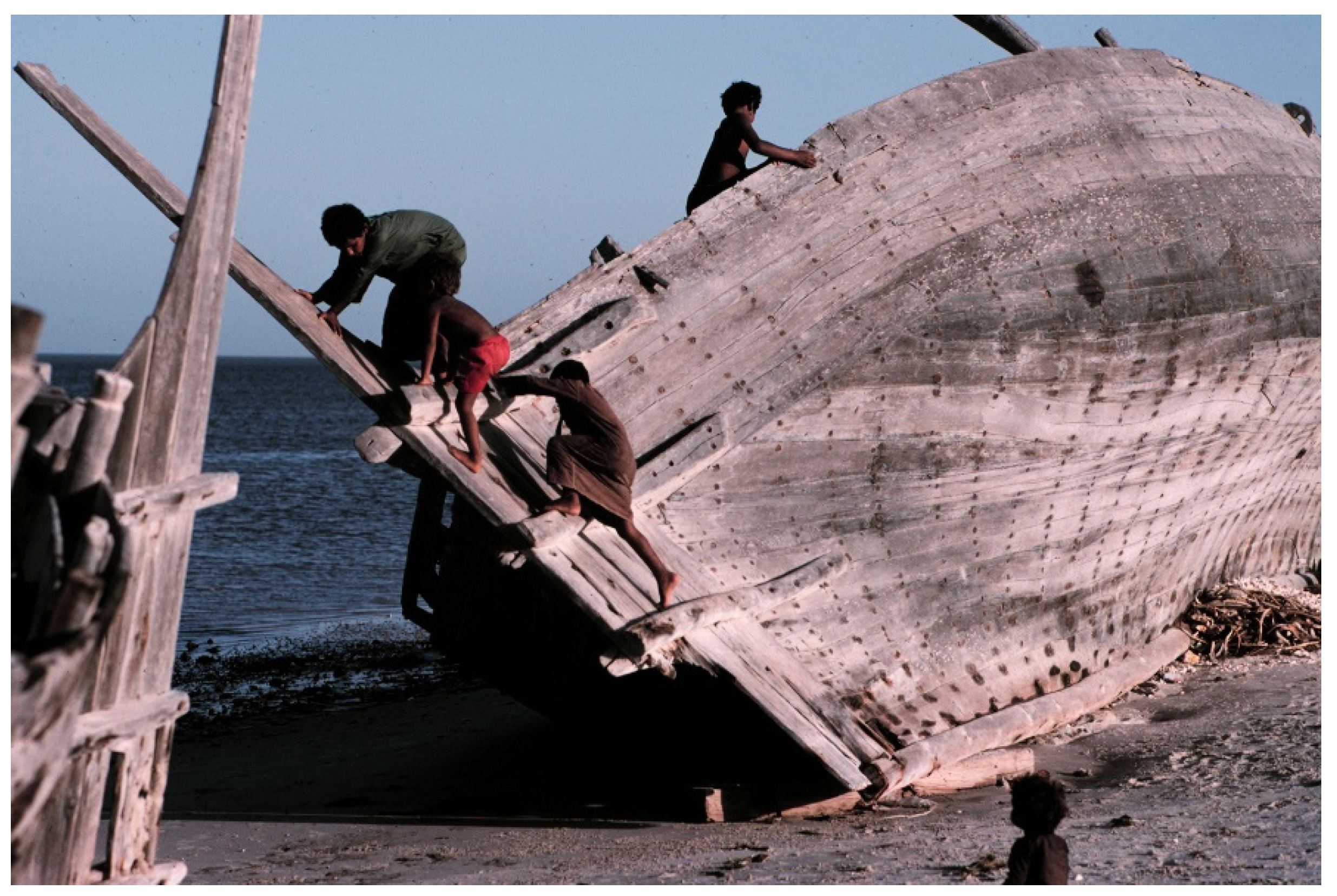
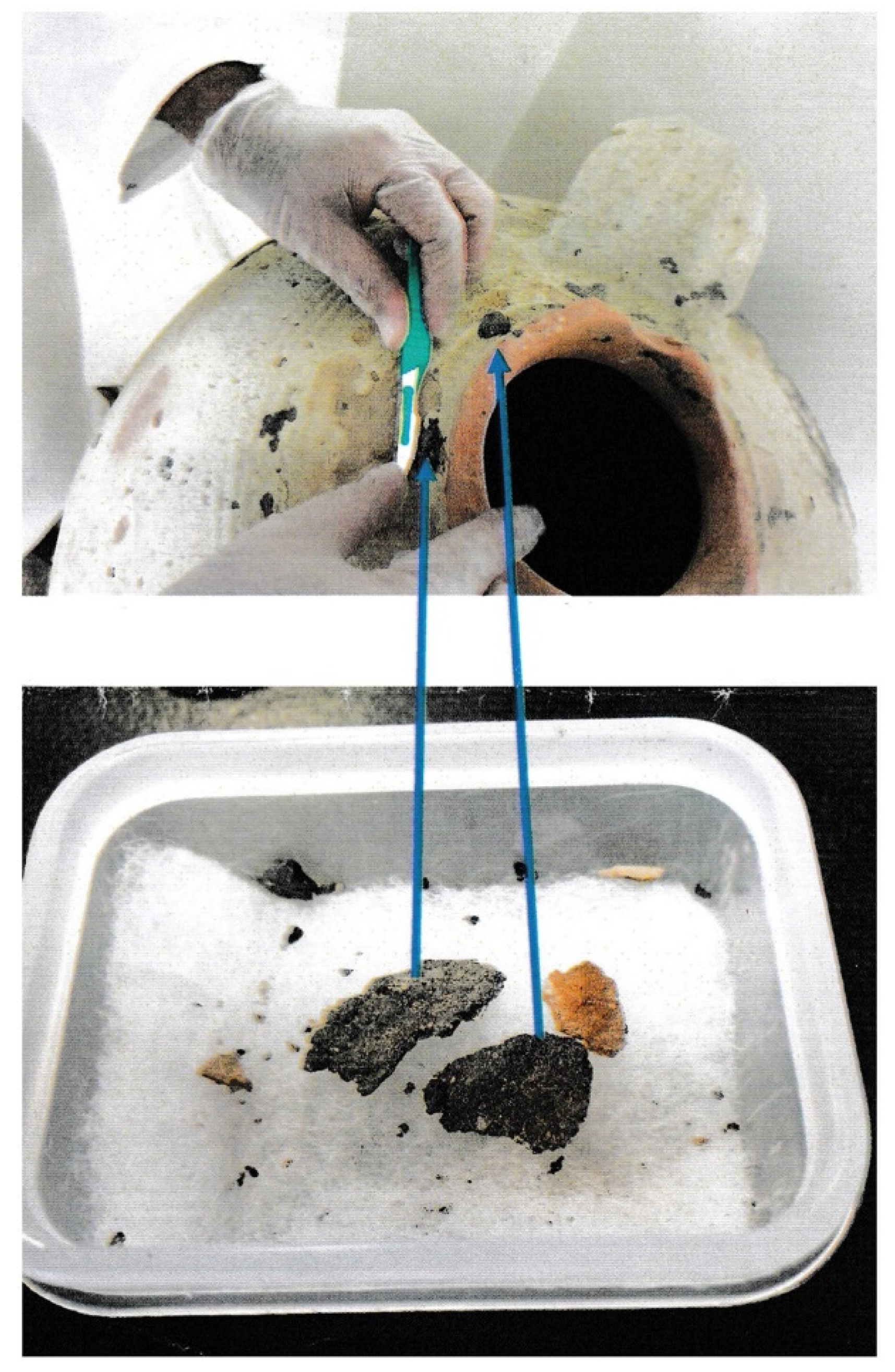
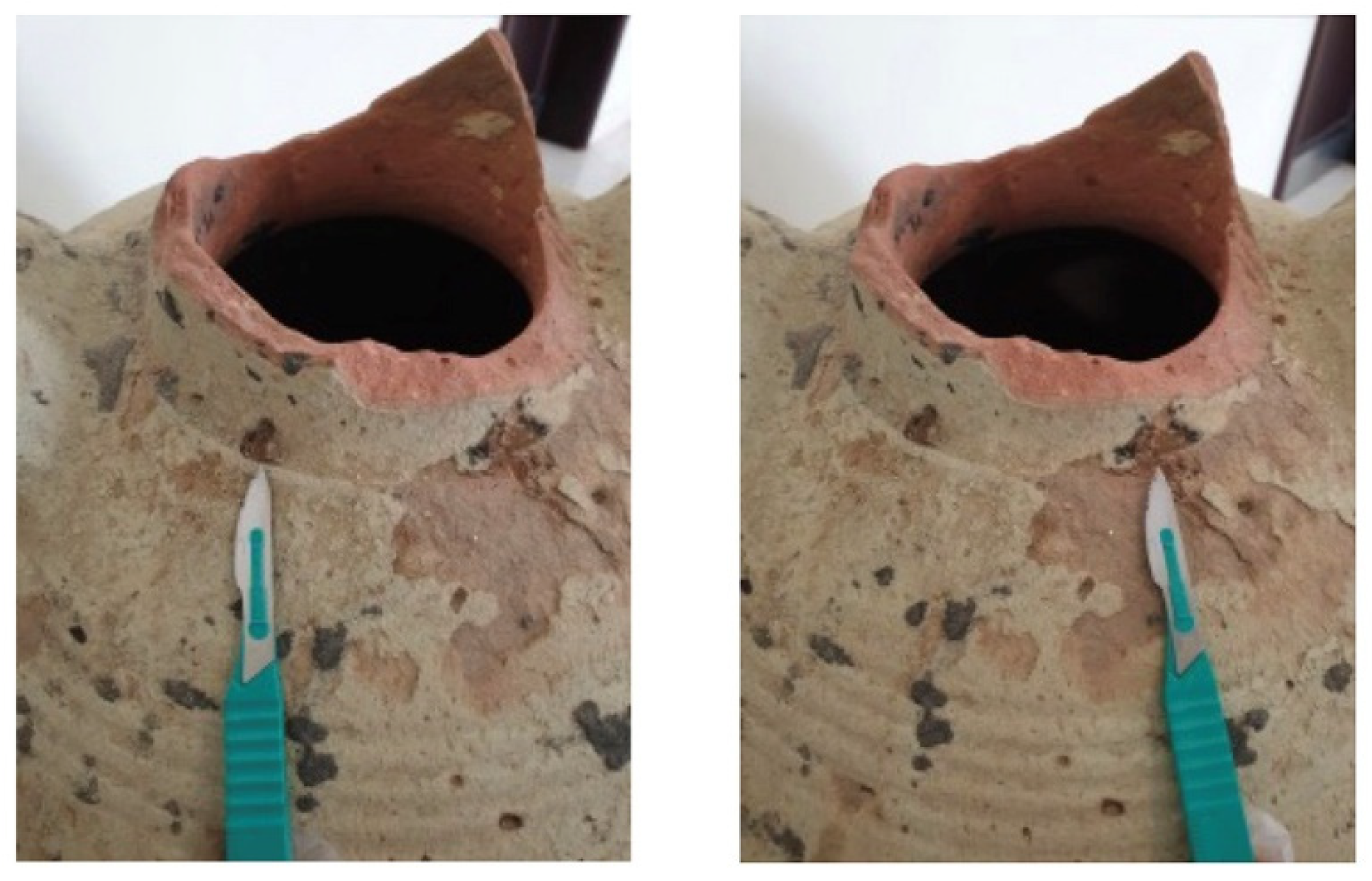
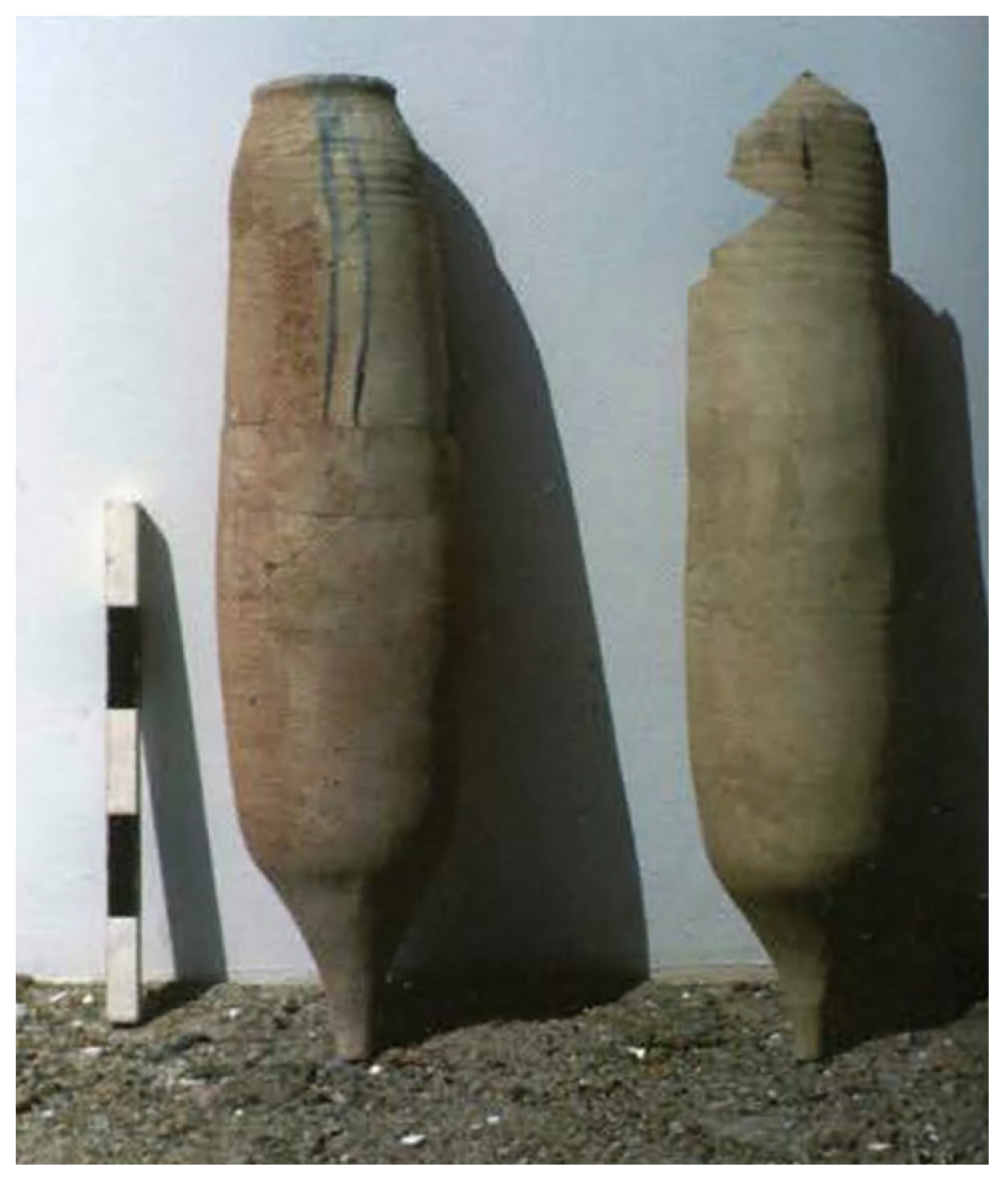
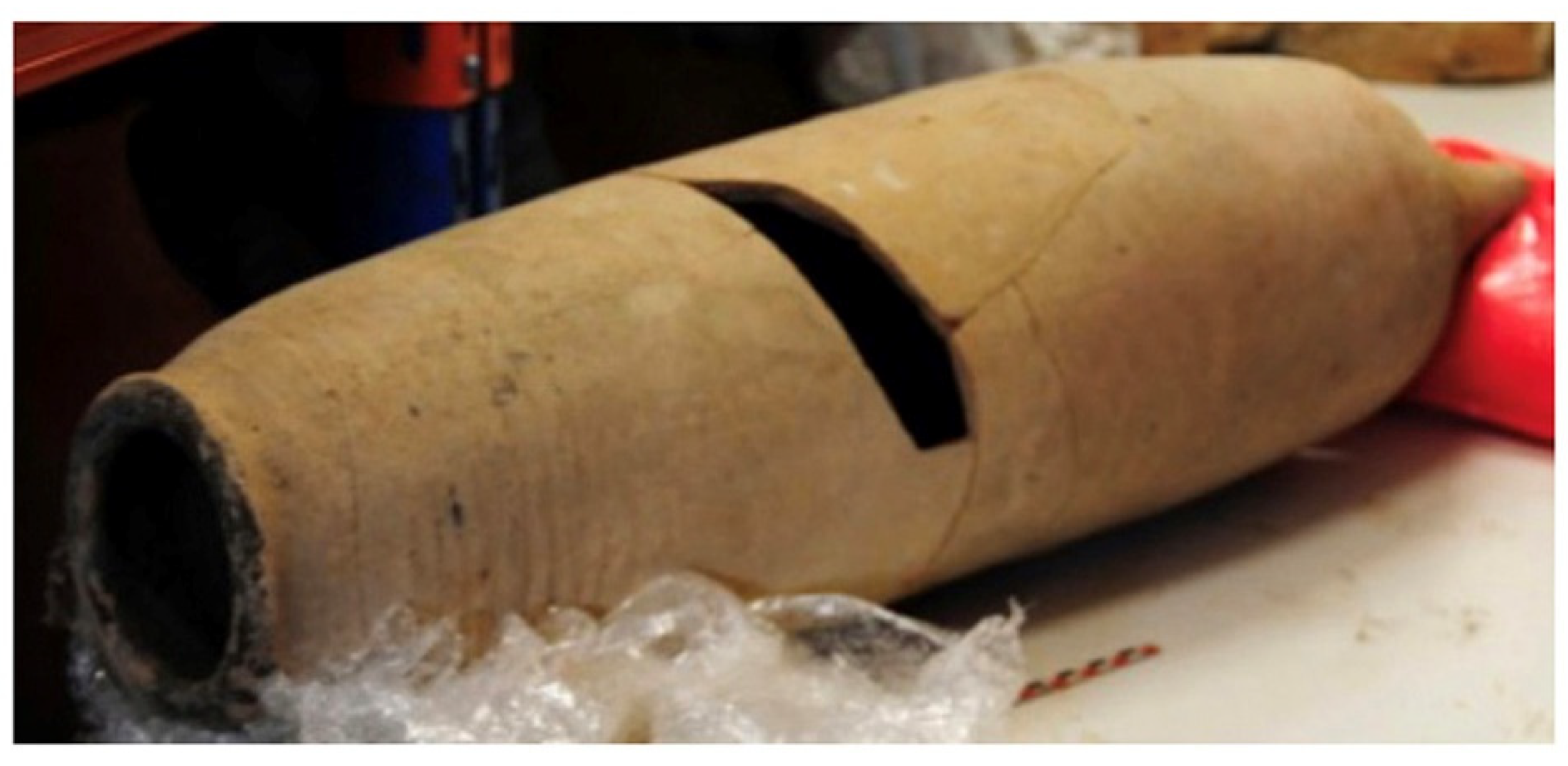

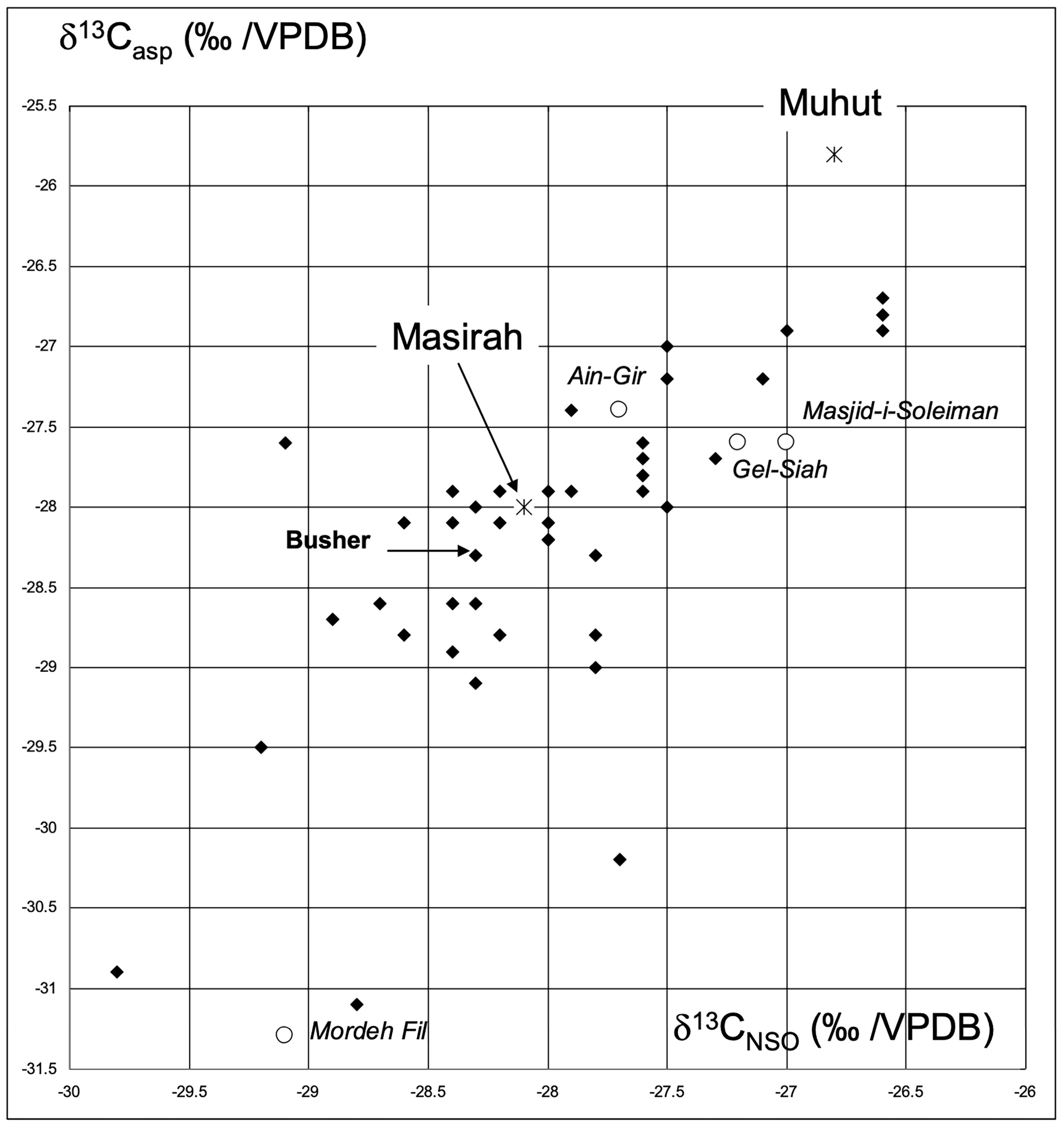
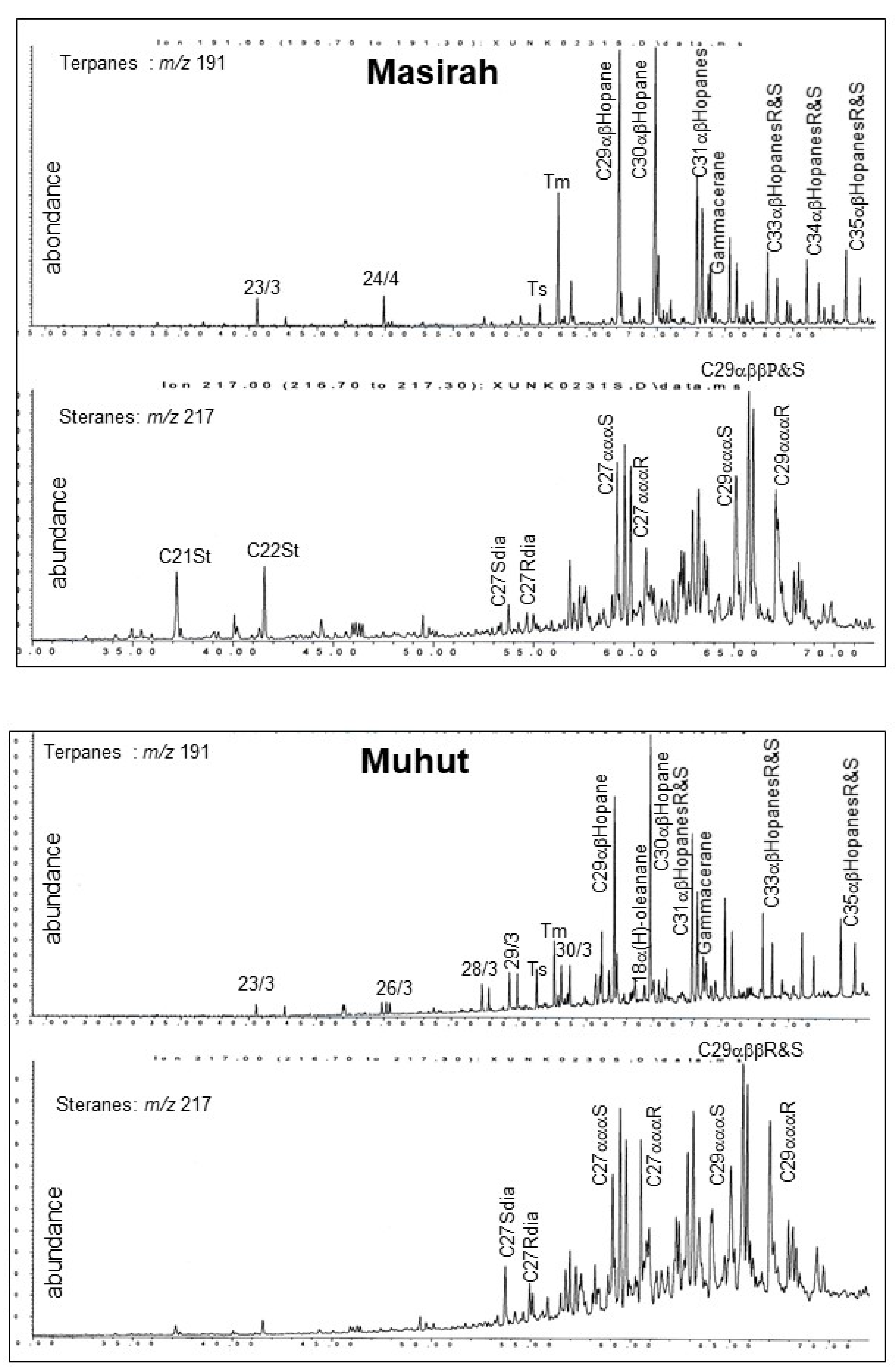
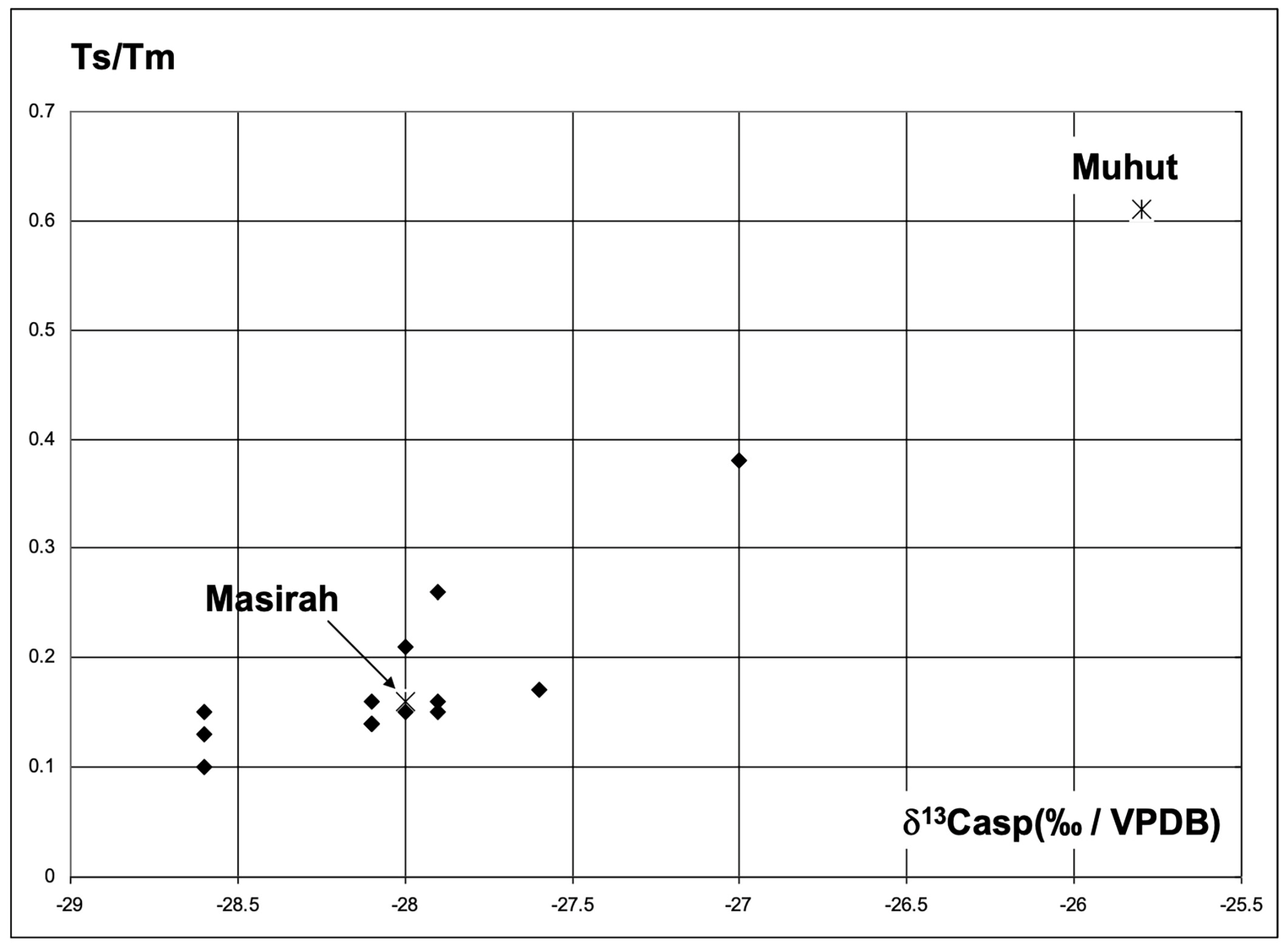
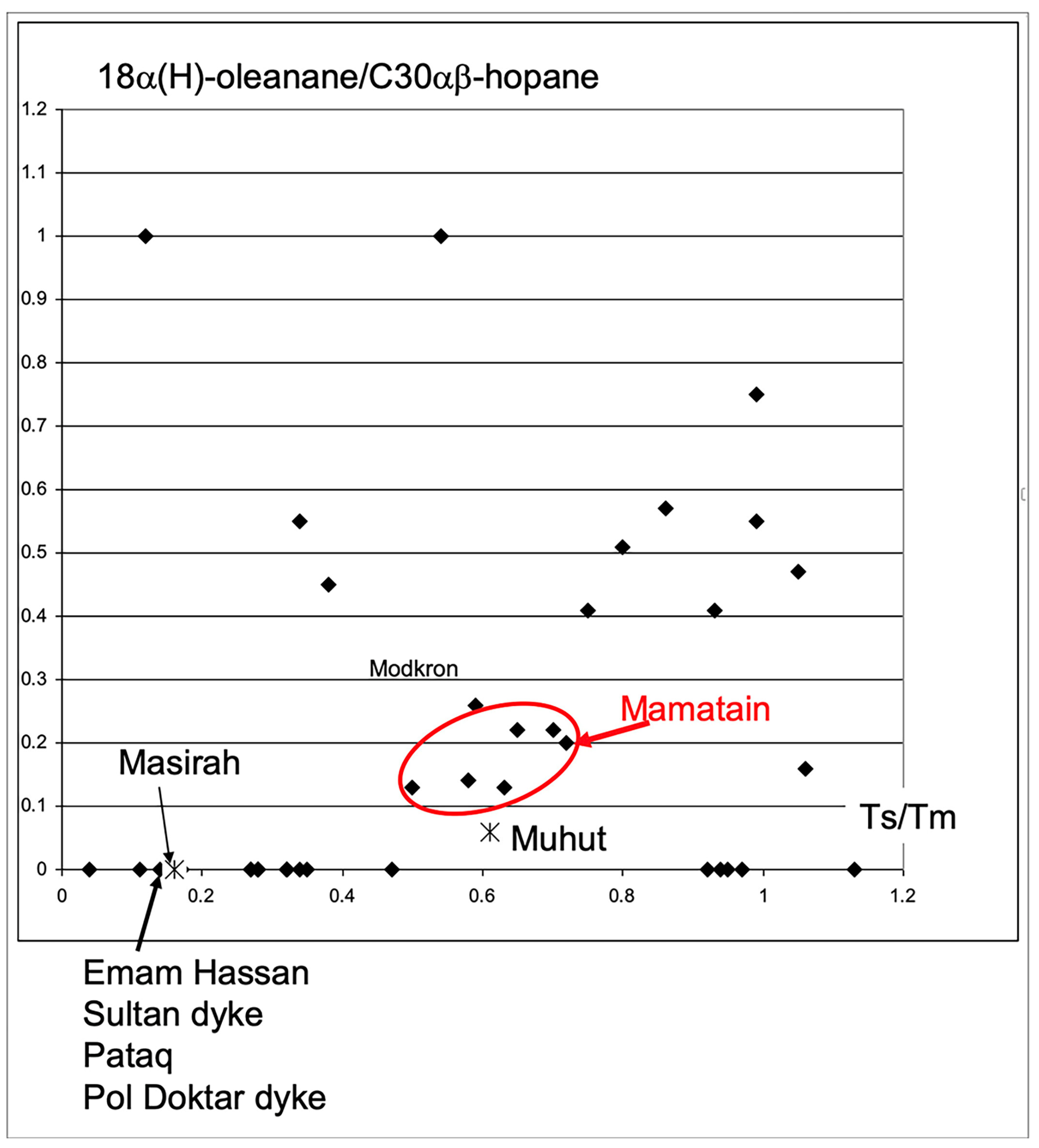
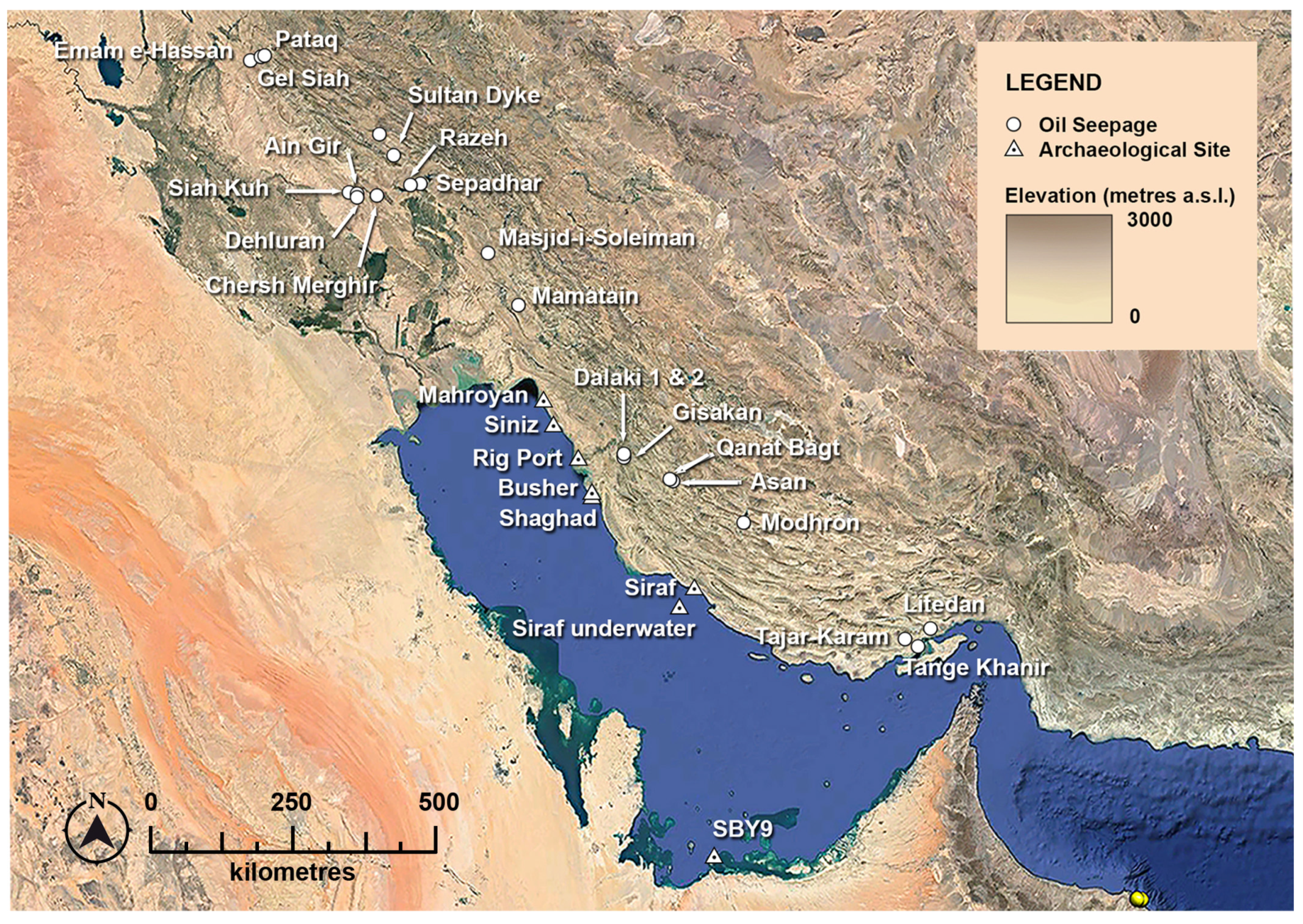
| Lab No. | Object | Location | % extract | % sat | % aro | % NSO | % asp | δ13Csat (‰/VPDB) | δ13Caro (‰/VPDB) | δ13Cresin (‰/VPDB) | δ13Casp (‰/VPDB) | δDresin (‰/VSMOW) | δDasp (‰/VSMOW) |
|---|---|---|---|---|---|---|---|---|---|---|---|---|---|
| 3284 | Muhut amphora | Jazirat Muhut | 19.2 | 9.6 | 10 | 33.7 | 46.7 | −27.2 | −26.7 | −26.8 | −28.8 | −115 | −108 |
| 3285 | Amphora DA7383 | Masirah Island | 49.4 | 2.2 | 1.5 | 8.7 | 87.6 | −28.4 | −27.6 | −28.1 | −28.0 | −86 | −73 |
| Lab No. | Object | C30 hopane (ppm) | C29H/C30H | OI/H | C31R/H | GA/C31R | Ster/terp | Dia/Reg | %C27 | %C28 | %C29 | C29 20S/R | C29ββS/ααR | Ts/Tm |
|---|---|---|---|---|---|---|---|---|---|---|---|---|---|---|
| 3284 | Muhut amphora | 604 | 0.77 | 0.06 | 0.41 | 0.39 | 0.33 | 0.37 | 30.6 | 30.9 | 39.6 | 0.71 | 1.18 | 0.61 |
| 3285 | Amphora DA7383 | 4653 | 0.99 | 0 | 0.42 | 0.42 | 0.2 | 0.37 | 32.3 | 25.3 | 42.4 | 1.08 | 1.59 | 0.16 |
Publisher’s Note: MDPI stays neutral with regard to jurisdictional claims in published maps and institutional affiliations. |
© 2021 by the authors. Licensee MDPI, Basel, Switzerland. This article is an open access article distributed under the terms and conditions of the Creative Commons Attribution (CC BY) license (https://creativecommons.org/licenses/by/4.0/).
Share and Cite
Connan, J.; H. Engel, M.; Jackson, R.B.; Priestman, S.; Vosmer, T.; Zumberge, A. Geochemical Analysis of Two Samples of Bitumen from Jars Discovered on Muhut and Masirah Islands (Oman). Separations 2021, 8, 182. https://doi.org/10.3390/separations8100182
Connan J, H. Engel M, Jackson RB, Priestman S, Vosmer T, Zumberge A. Geochemical Analysis of Two Samples of Bitumen from Jars Discovered on Muhut and Masirah Islands (Oman). Separations. 2021; 8(10):182. https://doi.org/10.3390/separations8100182
Chicago/Turabian StyleConnan, Jacques, Michael H. Engel, Robert B. Jackson, Seth Priestman, Tom Vosmer, and Alex Zumberge. 2021. "Geochemical Analysis of Two Samples of Bitumen from Jars Discovered on Muhut and Masirah Islands (Oman)" Separations 8, no. 10: 182. https://doi.org/10.3390/separations8100182
APA StyleConnan, J., H. Engel, M., Jackson, R. B., Priestman, S., Vosmer, T., & Zumberge, A. (2021). Geochemical Analysis of Two Samples of Bitumen from Jars Discovered on Muhut and Masirah Islands (Oman). Separations, 8(10), 182. https://doi.org/10.3390/separations8100182






